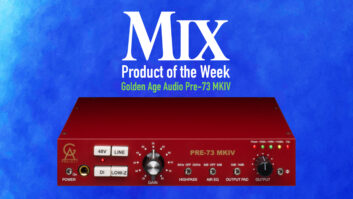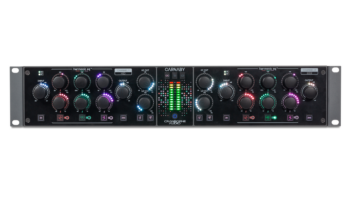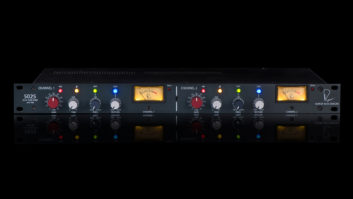
In 1971, Led Zeppelin bass and keyboard player John Paul Jones ordered a custom-built console for his recording studio. Decades later, Wunder Audio owner Mike Castoro got his hands on a preamp/EQ module from that one-of-a-kind board and was blown away by its sound. Castoro spent the next four years designing and implementing 20 modifications for the module, resulting in the Wunder Audio PEQ1.
SOLID, IN AND OUT
The solid-state, fully discrete, Class-A PEQ1 can be ordered either as a stand-alone mono module with 18-pin, gold-plated Amphenol connector ($2,250 list) or in a 1- or 2-channel rackmountable chassis that also provides XLR and TRS connections for mic, line and instrument inputs and line output. (More on these connections in a bit.) Although the circuitry for the PEQ1 is unique, Castoro made the stand-alone module’s form factor and pin-out configuration fully compatible with Neve 1073 modules so that it could serve as a direct replacement in Neve 80 Series consoles or outboard racks designed for the 1073.
I reviewed a single PEQ1 module mounted in a 3U, 2-channel Wunder Audio powered rack, designed by Boutique Audio & Design. The rack adds $695 to the module’s list price: A Boutique rack loaded with two PEQ1s costs $5,195. Castoro told me that his company will offer a single-channel module (the PEQ1R; $2,250) mounted in a Wunder Audio 1U rackmountable chassis by the time you read this. An outboard lunchbox-style power supply ($299) will be required for use in this configuration; the power supply will purportedly be able to power up to 24 daisy-chained PEQ1Rs. Similar to the Boutique version, the PEQ1R will offer XLR and TRS connections for mic, line and instrument inputs and line output.
My review unit provided separate balanced XLR connectors for mic and line inputs and line output on the rear panel. A balanced TRS input (which also accepts unbalanced signals) on the unit’s front panel is wired in parallel with the unit’s rear panel line input and can accommodate instrument or line-level signals. All I/Os go to custom-designed transformers (exact replicas of those used in Jones’ desk), which are key to the PEQ1’s sonic signature.
The unit’s build quality looks solid. Components include conductive-plastic Vishay pots, custom Elma switches and large Sprague “Orange Drop” capacitors for the EQ circuitry. The PEQ1’s frequency response — with EQ switched out — is an impressive 20 Hz to 115 kHz, +0/-1 dB. Maximum output level is a respectable +23 dBm into 10 kilohms. Noise is better than -125 dB from 10 Hz to 20 kHz.
FINE FEATURES
The PEQ1 module offers separate control knobs for input gain and each of its three bands of EQ. Switches are also provided for choosing alternate input source (mic or line/instrument), global EQ bypass and phase inversion. The Boutique rack adds switches for AC, phantom power and a rotary attenuator (which goes to complete silence when set fully counterclockwise) for output level. The PEQ1R will also purportedly incorporate all of these features except the power switch, which will be on its outboard power supply.
The PEQ1’s input gain control provides from 18 to 78 dB of gain for mic signals and a whopping 60 dB of gain for line and instrument inputs — plenty for recording instruments straight to tape or disk. Hash marks for input gain follow British convention: Values indicate the amount of gain applied to achieve the rated output level (in this case, 0 dBm). For example, the gain knob would need to be set to “-12” to achieve 0dBm output level on -12dBm input. Screening on one side of the knob indicates gain boost for mic input, while the other side shows gain boost for line and instrument inputs.
The PEQ1 provides shelving EQ for high and low bands and a bell curve filter for mids. The stepped (fixed) frequency and continuously variable gain controls for each band are concentrically arranged. There is no Q control for the mids; filter bandwidth varies between roughly ⅔ and 8/10 octave, depending on which center frequency is chosen. Choices of frequencies include 40, 60, 100, 160 and 200 Hz for lows; 0.36, 0.7, 1.3, 2.4, 3.6 and 5.8 kHz for mids; and 7, 10, 12.5, 15 and 20 kHz for highs. There is no overlap in center frequency choices between bands, and a band can only be independently bypassed by setting its frequency control to an off position.
A separate bypass switch for each band would have allowed users to retain each frequency selection in bypass mode and perform instantaneous A/B comparisons per channel. Another practical disadvantage is that the brass boost/cut knobs, though beautiful, are plated with a shiny nickel finish that made it very difficult to ascertain settings in many lighting conditions. [Editor’s note: Wunder says the knobs are also available in a glare-free, clean anodized aluminum.] These knobs also lack zero detents. The maximum boost/cut provided is roughly ±21 dB for midrange frequencies and ±20 dB for lows and highs.
WUNDERFUL SOUND
Before using the PEQ1 in my sessions, I A/B’d its mic pre (EQ switched out) with an exceedingly accurate Millennia HV-3D to get a handle on its sound. Recording a nylon-string guitar, the HV-3D offered noticeably faster transient response and more depth and transparency as compared to the PEQ1. The PEQ1’s mic pre wasn’t as sparkly, open and detailed as I would’ve liked.
I quickly learned that this unit’s forte wasn’t transparency but making things sound big. Recording male lead vocals through the PEQ1’s pre with a Lawson L251 tube condenser set to omni mode and applying mild cut below 160 Hz and boost at 20 kHz with the PEQ1’s EQ, the sound was lush and round with plenty of detail and depth.
Playing my ’62 Strat through Roland’s fabulous MicroCube amp, I miked the cabinet with an L251 in bi-directional mode and used the PEQ1’s preamp again for gain. The sound was perfect: huge, creamy and tightly focused. The guitar track had a raspy cut without sounding brittle.
Recording electric bass guitar via the PEQ1’s front panel instrument jack, I anticipated hearing a dull sound due to expected pickup loading (considering that the instrument input follows the same audio path as line-in), but, boy, was I wrong! With the EQ switched out, the bass guitar was delightfully present without sounding glaring or thin. In fact, the sound was so rich and full that I would’ve sworn that this was a tube pre, except that the sound also had a solid-state focus. Best of all, the PEQ1’s bottom goes all the way to China! The bass track’s thunderous, fat, growly and aggressive sound eclipsed that produced from any dedicated DI — tube or solid-state — that I’ve ever used with that same bass guitar.
In other sessions, I got fat and snappy tracks recording congas, djembe, cowbell and handclaps in turn through the PEQ1 (using a B&K 4011 mic). Here, applying a touch of the PEQ1’s low- and high-shelving boost added extra dimension to the tracks.
I also put its line input and EQ to good use during several mixdown sessions, alternately shaping kick, snare drum and bass guitar tracks. The sound was always warm, robust and full-bodied, yet tightly focused. The PEQ1’s EQ sounded especially musical on rock drums. Very responsive yet smooth, this is colorful EQ you can readily hear.
SOLID, IN AND OUT
The PEQ1 would not be my choice for recording, say, delicate stringed instruments where transparency and detail are paramount goals. But for drum, percussion, electric guitar and vocal tracks that make a bold statement, the PEQ1 is an outstanding choice. And you gotta hear it on bass guitar!
Wunder Audio, 512/338-6777, www.wunderaudio.com.
Mix contributing editor Michael Cooper is the owner of Michael Cooper Recording in beautiful Sisters, Ore.







